Politics
In Graphs: India's Vaccination Drive In July
Venu Gopal Narayanan
Aug 02, 2021, 02:49 PM | Updated 05:35 PM IST
Save & read from anywhere!
Bookmark stories for easy access on any device or the Swarajya app.
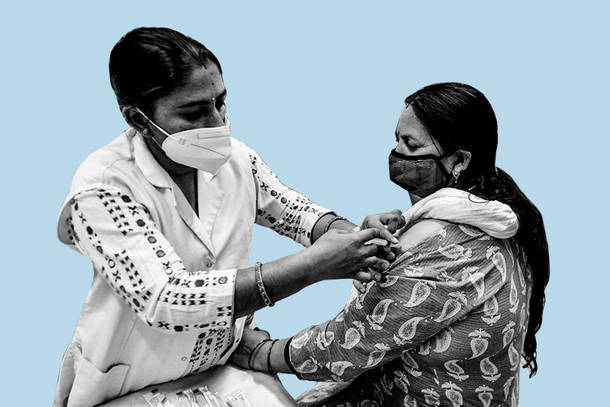
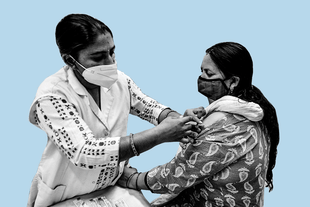
The Indian government’s ongoing effort to protect its citizens from the Wuhan virus is the largest, fastest, and most effective vaccination drive in human history. No one expected us to succeed, and there was enough chatter to suggest anticipatory schadenfreude that we wouldn’t. But, the July 2021 data shows that we have indeed turned a critical corner.
It was clear to analysts by late May itself that July would be a moving month. If we could somehow get through July without a third wave breaking out, while administering at least 3-4 million jabs a day, then we would have successfully vaccinated two critical portions of our population – the bulk of the elderly, who are the most susceptible, and a segment of the young, who are our workforce.
Vitally, that would take pressure off public health systems, which were overwhelmed by the second wave, while permitting the economy to commence its recovery through an easing of lockdown restrictions.
In the end, that’s what happened, the public health mess in Kerala and Maharashtra notwithstanding. Vaccinations finally began to pick up the pace, in step with an agonisingly gradual ramping up of vaccine production, and the dreaded third wave stayed away.
The numbers are staggering.
132.6 million doses were administered in July, at a daily average rate of 4.3 million. This is well above the target of 120 million for the month and brings the total to 463.1 million. In effect, India vaccinated a New Zealand a day, a Venezuela a week, and a Japan this month (July).
That means 361 million Indians have received at least one dose, and 102 million are fully vaccinated. This is well above the official December 2020 assessment that India would administer 300 million doses by end-August. Of course, there is some way to go for a nation of 1.4 billion people; the largest segment is below 18, vaccines for children are still in the trial stage, and we would need to jab at a rate of over 10 million a day, if we are indeed to inoculate every adult India by the end of the year.
Nonetheless, 41 per cent of the presently eligible population (adults; above 18), or 31 per cent of the total population, have received one dose by the end of July, and 14 per cent of those eligible are fully vaccinated (11 per cent of the total population).
99.9 per cent of the vaccines administered are manufactured in India. Sputnik arrived from Russia in May, but only half a million doses have been administered till date. The bulk, therefore, is Covishield (87.9 per cent), and is expected to remain so this year. Bharat Biotech’s Covaxin has provided 12 per cent.
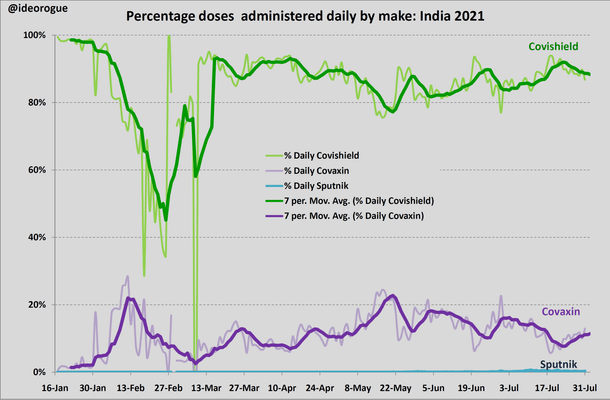
The vaccine supply target for August is around 150 million doses. Adding the 10 million doses in hand with the states as of end-July, potentially, 5.2 million doses can be administered every day this month. That is doable, provided supply and distribution hold up and is about a million more than the July average of 4.3 million a day.
It is, however, also possible that vaccine supply may touch 200-220 million doses in August, although this figure remains unconfirmed at present. Either way, supply stagger will have to be accepted as a way of life for the coming few months, rather than as an opportunity for negativism or needless politicking.
Consequently, vaccine coverage is a mixed bag at the state level and will remain so, until the gaps start closing out in September. Chart 2 below shows just how wide the gaps presently are, amongst most large states of the Union:Chart 2: Percentage of eligible population vaccinated with one dose
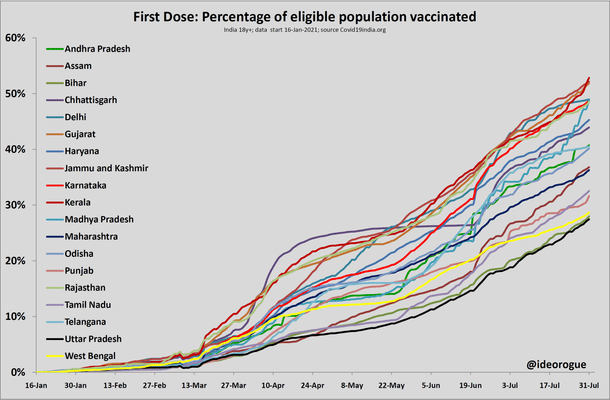
We see that the spread ranges from a quarter to over half. Much of this disparity is a function of low urbanisation, legacy issues of inadequate health infrastructure, and population size. Note how Uttar Pradesh, Bihar and West Bengal cluster at the bottom.
This disparity becomes more pronounced when we look at the fully vaccinated statistics in Chart 3 below:
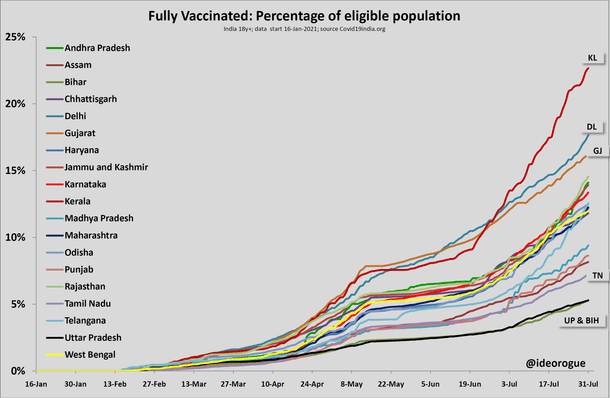
One thing we don’t know is the precise quanta and delivery schedules of doses made to each state since January 2021. Consequently, it would be premature and imprudent to draw authoritative inferences of good or bad administrative practices, just yet.
Nonetheless, analysis of how states performed in July shows that most achieved, or overshot, their target for the month. Again, further interpretation is presently limited, until month-wise opening and closing stocks of vaccines for every state and union territory are made available along with dose delivery volumes and dates.
West Bengal, Andhra Pradesh and Jharkhand were on the watch list when Swarajya made its mid-month vaccination review (see here). At the end of the month, they continue to lag well behind others. The union government should take note, since this is exactly the sort of consistency not required at the moment.
Uttar Pradesh missed its target by more than was anticipated in the mid-month review, which means that this is a supply issue. Presumably, greater supply will aid the state in covering up the gap during the course of this month.
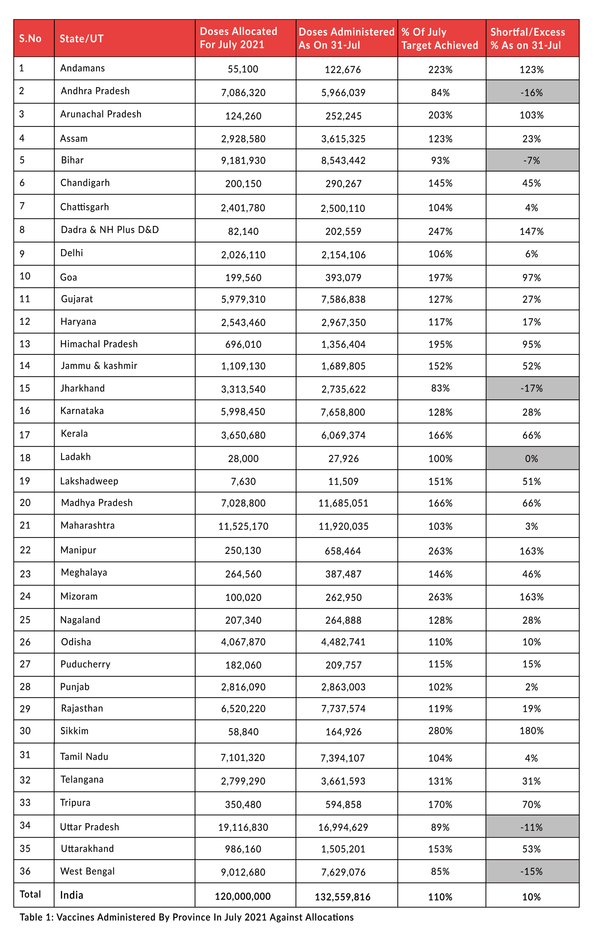
On the other hand, Madhya Pradesh is noted to be the fastest mover during July. When it registered record vaccinations on one day in late June, many thought that this was a one-off event; but no, the July data shows that the state has set a scorching pace and caught up with the upper band.
Overall, we see that Kerala has fully vaccinated the largest percentage of its eligible population; 23 per cent. It is followed by Delhi and Gujarat (see Chart 3). While there is presently a wide gap between these three states and the rest, it is expected that the gap will narrow, as a number of large states accelerate their jab rates, vaccine supplies rise, and hesitancy dissipates. Conclusion: India is on track.
India’s vaccination drive is being tracked and analyzed continuously by Swarajya, and further findings will be shared in our planned mid-August review.
All data from Covid19india.org
Venu Gopal Narayanan is an independent upstream petroleum consultant who focuses on energy, geopolitics, current affairs and electoral arithmetic. He tweets at @ideorogue.





